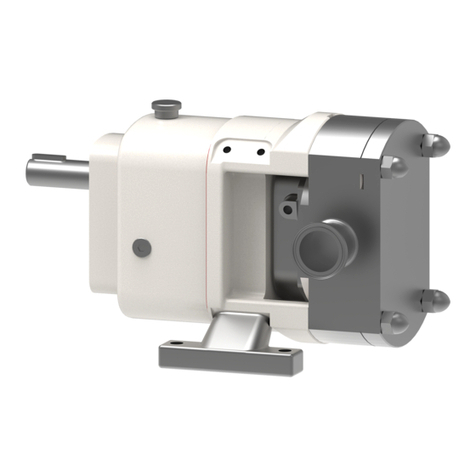Page 5
The mounting of the pump or pump unit should be solid and stable. Pump
orientation must be considered in relation to drainage requirements. Once
mounted, shaft drive elements must be checked for correct alignment. Rotate
pump shaft by at least one full revolution to ensure smoothness of operation.
Incorrect alignment will produce excessive loading and will create high
temperatures and increased noise emissions. It may also be necessary to
earth the pump to avoid the build up of a potential charge difference that could
cause a spark
The installation must allow safe routine maintenance and inspection (to
replenish lubricants, check for leakage, monitor pressures, etc) and provide
adequate ventilation necessary to prevent overheating.
Fill with the recommended grades and quantities of lubricant see section 3.4.
Beware of over/under filling the gearbox as this could cause the pump to
overheat and mechanical damage to occur.
Before operating the pump, ensure that it and all parts of the system to which it
is connected are clean and free from debris and that all valves in the suction
and discharge pipelines are fully opened. Ensure that all pipe work connecting
to the pump is fully supported and aligned with its relevant connections.
Misalignment and/or excess loads will cause severe pump damage. This could
result in unexpected mechanical contact in the pump head and has the
potential to be a source of ignition.
Ensure that pump rotation is correct for the desired direction of flow; (see
section 3.4)
Do not install the pump into a system where it will run dry (i.e. without a supply
of pumped media) unless it is equipped with a flushed shaft seal arrangement
complete with a fully operational flushing system. Mechanical seals require a
thin fluid film to lubricate the seal faces. Dry running can cause excessive heat
and seal failure.
Install pressure gauges/sensors next to the pump suction and discharge
connections to monitor pressures.
Caution must be taken when lifting the pump. Suitable lifting devices should be
used as appropriate. If pump is baseplate mounted, the base plate must be
used for all lifting purposes, not any part of the pump. If slings are used for
lifting, they must be safely and securely attached. For weights of bare shaft
pumps refer to section 5.5.
DO NOT attempt any maintenance or disassembly of the pump or pump unit
without first ensuring that:
- The pump is fully isolated from the power source (electric, hydraulic,
pneumatic).
- The pumping chamber and any shaft seal support system, front cover
barrier support system, and rotorcase port barrier support system are
de-pressurised and purged.
- Any temperature control devices (jackets, heat-tracing, etc) are fully
isolated, that they are de-pressurised and purged, and components
allowed to reach a safe handling temperature.
DO NOT loosen or undo the front cover, any connections to the pump, shaft
W
WA
AR
RN
NI
IN
NG
G
W
WA
AR
RN
NI
IN
NG
G
W
WA
AR
RN
NI
IN
NG
G
W
WA
AR
RN
NI
IN
NG
G
W
WA
AR
RN
NI
IN
NG
G




























